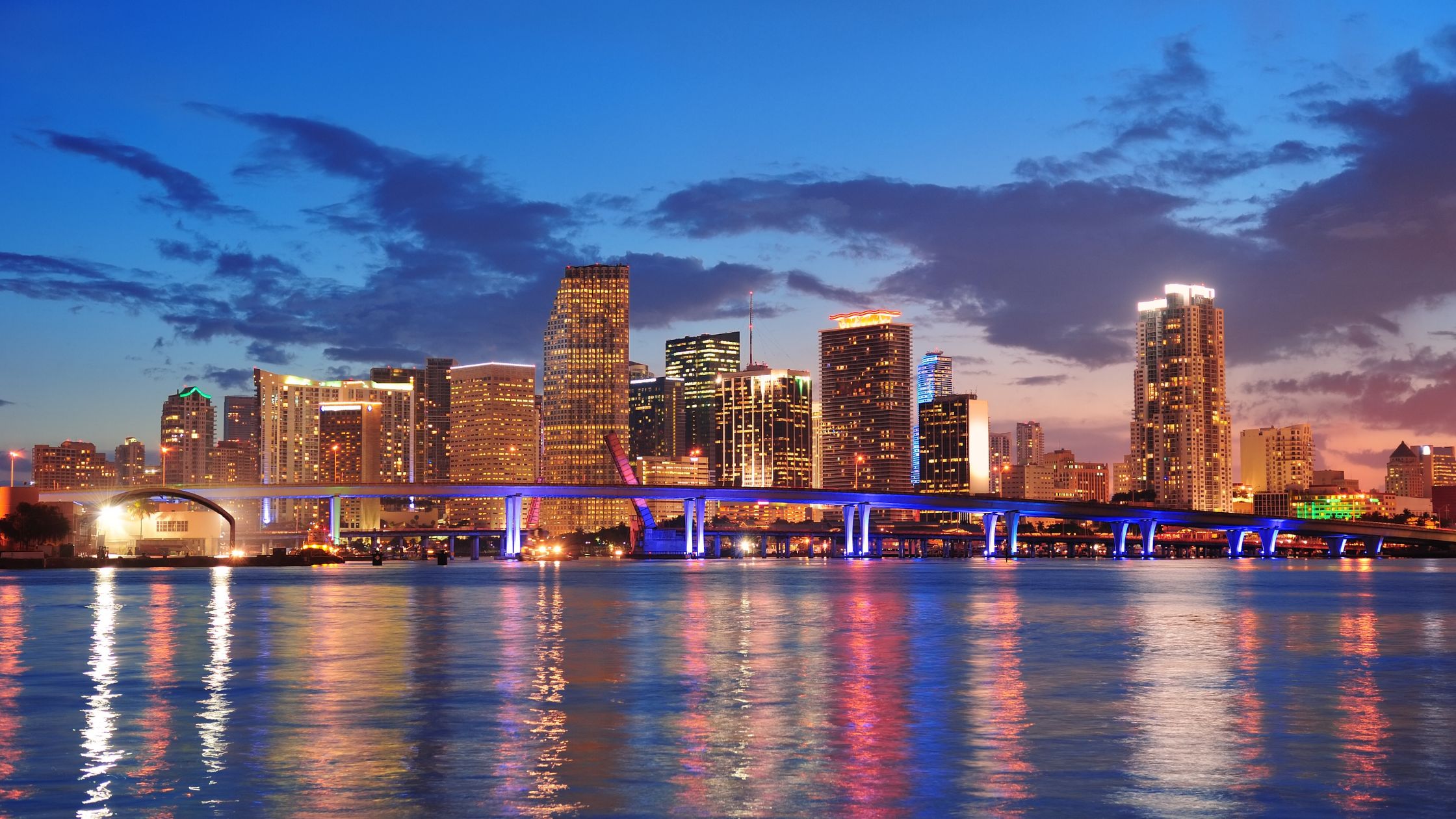Florida commercial real estate trends continue to outperform most US markets because of strong job growth and economic momentum.
The state now supports over 10 million jobs, and in December 2024 alone, more than 53,000 new businesses were formed. Florida’s real GDP grew by 3.8% and outpaced the national average of 2.7%.
Central and South Florida, in particular, remain high on the radars of buyers interested in investing in Florida commercial property. These regions benefit from rising population density combined with strong migration trends and targeted infrastructure spending.
Florida CRE market insights point to Miami as an investment magnet. It ranks second nationally for CRE investment in 2025 because of its unique position as a gateway to Latin America and a growing hub for finance, tech, hospitality, and entertainment.
Many firms are relocating or expanding in the area to benefit from Florida’s tax advantages.
Major infrastructure investments — including transit upgrades and airport improvements — have further expanded its connectivity.
Miami’s appeal as a residential destination also remains strong because of its coastal location and tropical climate.
This combination of livability and economic energy supports sustained demand across both commercial and residential sectors.
Tampa has likewise climbed to the third spot on CRE investment lists for 2025. Florida CRE market insights point to steady population growth — especially among young professionals and retirees — as the main reason.
This population growth has boosted demand in retail, office, and industrial markets, while local economic diversification — with expansions in tech, healthcare, and manufacturing — reinforces market resilience.
Interestingly, South Florida’s office market is also doing better than most. Rather than following the national trend of shrinking demand, the region is upgrading its office spaces with hospitality-inspired designs and mixed-use amenities.
Overview of Florida’s commercial real estate market
- Investment activity: Miami held its position as the second-most attractive US market for CRE investment in CBRE’s 2025 Investor Intentions Survey, just behind Dallas. Investors continue to show interest in both major gateways and fast-growing Sun Belt cities that may offer strategic price points.
- Investor sentiment: Roughly 70% of surveyed investors plan to expand their portfolios in 2025. Stronger property fundamentals and more favorable pricing conditions combined with optimistic Florida commercial real estate trends are driving this optimism.
- Property type preferences: Cited by 75% of respondents, multifamily remains the top target for buyers investing in Florida commercial property, followed by industrial and logistics at 37%. Interest in retail and office sectors is ticking upward compared to last year as markets stabilize.
- Investment strategies: Most investors — roughly two-thirds — favor value-add and core-plus approaches especially in markets where repositioning or operational improvement can unlock stronger yields.
Key CRE trends shaping Florida in 2025
Multifamily housing
Housing stats rebounded in February 2025 — however, developers continue to face rising material costs and labor shortages, slowing down some large-scale projects.
In 2025, builders are expected to focus on secondary markets and smaller-scale developments tailored to specific groups like millennials and downsizing empty nesters.
Suburban pockets around Tampa, Orlando, and Fort Lauderdale are drawing attention among renters priced out of city centers.
Meanwhile, build-to-rent communities — entire neighborhoods of single-family homes or townhomes designed for long-term tenants — are taking hold as a new alternative to traditional apartment living.
Also Read – Multifamily is New Favorite for CRE Investors
Industrial
Leasing activity in early 2025 softened across most warehouse sizes from 10,000 to 100,000 square feet. Lease rates are beginning to feel downward pressure with more available inventory entering the market.
Class A industrial rents average $20.88 per square foot IG in Miami, around $17.00/SF NNN in Broward, and $16.10/SF NNN in Palm Beach.
Owner-user demand remains high on the sales side. Average sale prices are $270/SF in Miami, $251/SF in Broward, and $199/SF in Palm Beach.
Even the cold storage segment has seen a pullback in leasing momentum. Meanwhile, demand for outdoor storage — with 1 to 3 acres and service facilities — is holding steady. Truck parking, however, is seeing weak interest.
Office space
Orlando’s office market picked up speed in 2024 with more than 2.8 million square feet in leasing activity.
That helped push net absorption into positive territory, ending the year with a 90,481 sqft gain — a sharp recovery from the earlier post-pandemic slump.
Class A offices in areas like Downtown Orlando, Lake Nona, and Maitland Center are in demand, with tenants looking for well-located spaces with flexible layouts, tech upgrades, and amenities that support both collaboration and hybrid work models.
Vacancy in Central Florida dipped slightly in Q4 2024 to close at 15.5% — a modest improvement, but a sign of growing stability. Rents have held firm with average asking rates at $27.29/SF.
One clear trend in 2025 is the “flight to quality.” Tenants increasingly prefer amenity-rich, modern offices that support productivity and employee well-being.
In response, developers and landlords are updating older properties and designing flexible layouts to cater to remote-first companies and branch offices.
Demand for smaller suites is also increasing especially among firms looking for scalable space and shared resources.
Retail sector
Orlando’s tourism boom and fast-growing population continue to fuel retail demand.
The market’s availability rate (including both vacant space and space that will soon be vacant) sits at just 3.9%, with asking rents up 4.5% year-over-year.
Total returns hit 8.9%, and 1.6% of inventory has been leased — this puts Orlando among the most active retail markets nationwide.
Tampa’s retail market is also holding strong despite a drop in transaction volume. Asking rents grew by 4.4% and total returns reached 7.8%.
Retail in Fort Lauderdale is picking up: 4.4% of space is currently listed as available and asking rents are up 1.4%.
Total returns reached 6.2%. Activity remains steady, with 1.6% of inventory leased across key corridors. Activity remains healthy across key corridors with 1.6% of inventory leased.
Hospitality and tourism properties
Preliminary data shows Florida welcomed 142.9 million visitors in 2024 — that’s a 1.6% increase over 2023 and a new record for the state.
Early reopening policies gave the state a head start and made it more appealing to domestic travelers.
Pent-up travel demand in late 2021 also translated into heavy booking activity through 2024. Cruise operations ramped back up, with ports in Miami, Fort Lauderdale, and Port Canaveral quickly returning to high volumes.
Regional hotspots and market dynamics
Miami: International capital, multifamily, luxury retail, and offices
Miami’s multifamily sector delivered around 13,000 new units in 2024.
Signs of oversupply are emerging as absorption rates hit 60%, though rent growth remained steady, rising 2.2% in Q3, close to the historical average of 2.6%.
Private buyers accounted for 60% of sales, with local investors making up 70% of that group. If you are looking for hard money lenders in Miami, then we are here to help you. We are direct private hard money lender in Miami.
Tampa Bay: Medical office, industrial, and suburban growth
Tampa absorbed 408,000 square feet of office space over the past year and lowered vacancy to 9.4%.
Asking rents rose 3.0% year-over-year. In the industrial sector, supply expansion pushed vacancies up to 7.3% and rents declined 3.1% to $9.44 per square foot.
Orlando: Hospitality, retail, and population-driven growth
Orlando’s population grew 2.1% in 2023, driving a 6.2% increase in retail asking rents to $29.01/SF by Q1 2024. Net absorption surpassed 108,000 square feet during the same period.
Multifamily rents dipped 1.2% in Q3 2024 but the influx of renters and limited homebuying options continue to stabilize the market.
Jacksonville: Industrial/logistics surge and workforce migration
Jacksonville’s industrial market remained active with 1.1 million square feet delivered in Q3 2024.
Sales of investment-grade properties reached $726.3 million across 6.5 million square feet in the first nine months.
Understanding commercial property valuation in Florida: The role of tourism, climate risks (flood zones), and insurance premiums
Proximity to Florida’s biggest attractions adds both value and risk. Hotels near International Drive or retail near Tampa’s Riverwalk see constant demand, but they also rely on tourism cycles.
Flood risk is now baked into every serious valuation. Waterfront condos in Miami Beach or resorts in the Keys may look like premium assets, but they also sit in high-risk zones. Appraisers and lenders look at FEMA maps and storm history — plus the cost of resiliency upgrades — before setting a number.
Insurance premiums are rising fast. In 2024, many commercial property owners in coastal counties saw double-digit increases or had trouble renewing coverage at all.
Higher premiums cut directly into NOI and forced some deals to reprice or fall apart entirely. Investors now factor in policy limits and exclusions alongside the rent roll.
Conclusion
Florida commercial real estate trends indicate that the Sunshine State will remain a stronghold for CRE investors, thanks to the combination of job growth, tourism strength, population migration, and pro-business policies that support long-term demand across asset types.
Investors need to understand local market conditions and know how to accurately price properties to succeed in 2025.
If you’re thinking of investing in Florida commercial property, you need to focus on fundamentals and carefully analyze your risk exposure.
More importantly, be sure to work with CRE financing sources that understand each submarket’s moving parts and can help you find value. Private Capital Investors is here to help you get started with their expert team of commercial real estate lenders in Florida.





